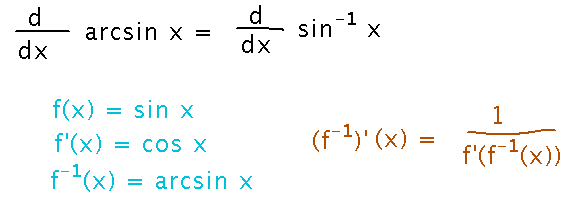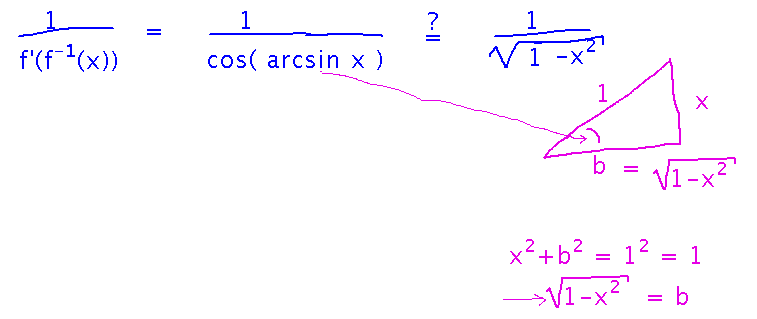Misc
SI today, 3:00 - 4:30, Fraser 104.
Questions?
Derivatives of Inverse Functions
Inverse function theorem: If function f(x) has derivative f’(x), then f-1(x) has derivative 1 / f’(f-1(x)).
What does this actually mean?
Simple Example
Let f(x) = x2, so f’(x) = 2x and f-1(x) = √x. We already know that the derivative of f-1 is 1/(2√x).

Can you get that same function by applying the inverse function theorem?
Yes, by noticing that f-1(x) is √x, so applying f’ to that yields 2√x, and finally the reciprocal is 1/(2√x).

Inverse Trigonometric Functions
Use the inverse function theorem to find the derivative of arcsin x aka sin-1x
Start by cataloging the pieces, to plug into the inverse function theorem.

Applying the inverse function theorem to these pieces is easy, but gives a result very different from what the Internet says is the derivative of sin-1x.

To see that these are actually the same, use the definitions of the trigonometric functions to label the sides of a right triangle in ways that produce an angle whose sine is x, then express the cosine of that angle in terms of the lengths of other sides:

This differentiation rule also leads to an antiderivative rule that is sometimes helpful:

You can similarly find derivatives of the other inverse trigonometric functions. For example, how about arctan aka tan-1?
Follow the same procedure, i.e., apply the inverse function theorem and then use a triangle to help express the various trig functions involved in terms of x, constants, etc. This time that’s a little trickier than it was for sin-1, because the functions in question are tangent and secant (secant squared, even), but the basic idea is the same:

And as before, there’s also an occasionally useful antiderivative rule too:

See section 3.7 of the textbook for derivatives of the other inverse trigonometric functions.
Next
Related rates problems.
Read section 4.1